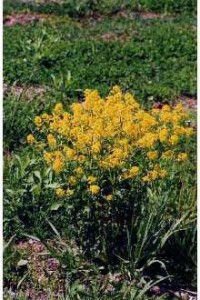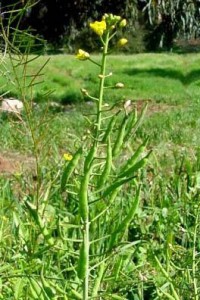 For many years I have had fun surprising my gardening friends by inter-planting my shrubs and flowers with vegetables such as tomatoes, sweet peppers, cabbage, Brussels sprouts, and others. That is until I moved to a house located in a heavily wooded area where sun was a valuable commodity. That’s when I discovered that many wild edible plants, like mayapples and fiddlehead ferns, happily grow in partial shade. Since some “noxious weeds” also like the same habitat, I thought it might be interesting to attempt growing some edible “weeds” in my garden.
For many years I have had fun surprising my gardening friends by inter-planting my shrubs and flowers with vegetables such as tomatoes, sweet peppers, cabbage, Brussels sprouts, and others. That is until I moved to a house located in a heavily wooded area where sun was a valuable commodity. That’s when I discovered that many wild edible plants, like mayapples and fiddlehead ferns, happily grow in partial shade. Since some “noxious weeds” also like the same habitat, I thought it might be interesting to attempt growing some edible “weeds” in my garden.
My maternal grandmother would always gather wild greens in the spring from farm fields and woodlots. She made them into a “spring tonic” and, as I recall, they had the same effect as a good dose of castor oil. She did teach me, however, to appreciate the value of these wayside plants both from an edibility and medicinal standpoint. I recall specifically as a kid when my older brother ended up with blisters after a poison ivy encounter. My grandmother went out into a damp section of the woodlot,brought back some Jewelweed, and in no time my brother’s itchy complaints were history.
Since then, I have tried to learn more about these curious plants that some people today look upon as “noxious weeds.” I have tasted such weeds as Jerusalem artichokes, burdock, cattails, chickory, daylilies, dandelion, lamb’s quarters, shepherd’s purse, mayapples, pigweed, purslane, sassafras, acorns, milkweed, mustard, watercress, and of course all sorts of fruit such as crab apples, persimmons, elderberries, blueberries, and blackberries.
 Being a mustard connoisseur, Wild Mustard has always caught my attention. It’s hard to discuss this member of the Brassica family because so many different plants are called wild mustard. There are about 10 different species of wild mustard. Fortunately all are edible. One of the best is Black Mustard (Brassica nigra) that inhabits many cultivated and uncultivated fields, waste ground, and roadsides. It is very similar to field mustard or turnip rape (B. rapa). I enjoy the strong, pungent flavor of black mustard. If you have any doubts about picking the right plant you may use a reference book on weeds or just ask any farmer and he will point you in the right direction.
Being a mustard connoisseur, Wild Mustard has always caught my attention. It’s hard to discuss this member of the Brassica family because so many different plants are called wild mustard. There are about 10 different species of wild mustard. Fortunately all are edible. One of the best is Black Mustard (Brassica nigra) that inhabits many cultivated and uncultivated fields, waste ground, and roadsides. It is very similar to field mustard or turnip rape (B. rapa). I enjoy the strong, pungent flavor of black mustard. If you have any doubts about picking the right plant you may use a reference book on weeds or just ask any farmer and he will point you in the right direction.
The stems of black mustard can be smooth or covered with scattered hairs. The lower leaves have a large terminal lobe with several pairs of smaller ones, all having fine teeth around the edges. The alternate leaves further up the stem have almost no leafstalks, lack lobes and have edges that are not toothed. The bright yellow flowers have 4 petals in the form of a cross and have 6 stamen; 4 long ones and 2 short ones. While the upper flowers are coming into bloom the lower ones are being replaced with elongated 4-sided seedpods containing small, dark brown seeds.
Wild mustard is a great vegetable and an excellent source of vitamins A, B1, B2, and C as well as many trace elements required for good nutrition. To be at their best, mustard greens should be gathered during the first warm weather of spring. They make a great boiled green with the right combination of bitterness and pungency. You need plenty of greens since they shrink while cooking. These are not like spinach and are a poor dish when half cooked. Starting with cold water, bring them to a boil and boil for at least 30 minutes, drain, season with bacon drippings, and serve with a vinegary pepper sauce. The vinegar will help mask some of the bitter flavor.
 As the weather warms up, the leaves become bitter and inedible but the buds soon begin to form. These buds are richer in vitamin A than the leaves and are loaded with protein. Like their cultivated cousin, broccoli, the buds make a delicious vegetable. The buds can be gathered until the flowers start to bloom but avoid gathering any of the very bitter little leaves. The buds should be boiled in salted water for about 3 minutes (do not overcook), drained, and seasoned with butter and a little vinegar. The taste and texture is reminiscent of broccoli except with a pungent, mustard flavor.
As the weather warms up, the leaves become bitter and inedible but the buds soon begin to form. These buds are richer in vitamin A than the leaves and are loaded with protein. Like their cultivated cousin, broccoli, the buds make a delicious vegetable. The buds can be gathered until the flowers start to bloom but avoid gathering any of the very bitter little leaves. The buds should be boiled in salted water for about 3 minutes (do not overcook), drained, and seasoned with butter and a little vinegar. The taste and texture is reminiscent of broccoli except with a pungent, mustard flavor.
The yellow blooms are soon followed by little four-sided seedpods. Just when the lower seedpods are beginning to burst open, gather up the
whole plant, strip off the seedpods and lay them on sheet of newspaper or a plastic sheet to dry for a few days. Once dry, the seedpods can be
cracked and the hulls separated from the ripe seed by a simple winnowing process.
The dried seeds can be ground in a food mill and will give you “Dry Mustard” just like you buy in the grocery store. To make “Prepared Mustard” requires a little more effort. Place some flour in a pan and toast it in a slow oven, stirring occasionally, until it is evenly browned. Mix equal parts of the browned flour with the ground mustard seeds. Moisten the mix with a mixture of equal parts of vinegar and water until you get the desired consistency. The browned flour/mustard seed and vinegar/water ratio can be adjusted to your own particular taste. You may give some zip to the prepared mustard by adding some grated horseradish.
A lot of people have forgotten about the drug store mustard plasters that were used to soothe aching muscles or relieve chest congestion due to a cold. To make a home made mustard plaster, mix equal parts of the ground mustard with raw flour and moisten with water to make a paste. Smear this paste thinly on a cotton cloth, cover with another cloth, and apply to the sore muscle. Leave it on for only about 20 minutes or until the skin becomes red. The patient will surely let you know when they cannot stand it any longer since the heat increases with time.
Wild mustard can be used as a healthy cooked vegetable from spring through summer. In the fall, the ground ripe seeds made into a wonderful condiment and even used medicinally. When my children were young, they thought it way cool to eat this “noxious weed.”
